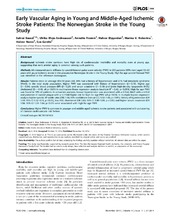Early vascular aging in young and middle-aged ischemic stroke patients: The Norwegian stroke in the young study
Saeed, Sahrai; Waje-Andreassen, Ulrike; Fromm, Annette; Øygarden, Halvor; Kokorina, Marina Victorovna; Næss, Halvor; Gerdts, Eva
Peer reviewed, Journal article
Published version

View/
Date
2014-11-18Metadata
Show full item recordCollections
Original version
https://doi.org/10.1371/journal.pone.0112814Abstract
Background: Ischemic stroke survivors have high risk of cardiovascular morbidity and mortality even at young age, suggesting that early arterial aging is common among such patients. Methods: We measured aortic stiffness by carotid-femoral pulse wave velocity (PWV) in 205 patients (69% men) aged 15–60 years with acute ischemic stroke in the prospective Norwegian Stroke in the Young Study. High for age carotid-femoral PWV was identified in the reference normogram. Results: Patients were on average 49±10 years old, 34% had a history of hypertension and 37% had metabolic syndrome (MetS). In the total study population, higher PWV was associated with history of hypertension (β = 0.18), higher age (β = 0.34), systolic blood pressure (BP) (β = 0.28) and serum creatinine (β = 0.18) and lower high-density lipoprotein (HDL) cholesterol (β = –0.10, all p<0.01) in multivariate linear regression analysis (multiple R2 = 0.42, p<0.001). High for age PWV was found in 18% of patients. In univariate analyses, known hypertension was associated with a 6-fold, MetS with a 4-fold and presence of carotid plaque with a 3.7-fold higher risk for high for age PWV (all p<0.01). In multiple logistic regression analysis higher systolic BP (odds ratio [OR] 1.04; 95% confidence interval [CI] 1.02–1.06; p<0.01), history of hypertension (OR 3.59; 95% CI 1.52–8.51; p<0.01), low HDL cholesterol (OR 3.03; 95% CI 1.00–9.09; p = 0.05) and higher serum creatinine (OR 1.04; 95% CI 1.01–1.06; p<0.01) were associated with high for age PWV. Conclusions: Higher PWV is common in younger and middle-aged ischemic stroke patients and associated with a clustering of classical cardiovascular risk factors.
